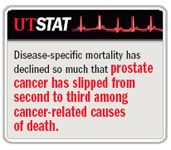Article
Dyslipidemia: Unexpected factor in declining prostate cancer deaths
The unexpected association between lower mortality and dyslipidemia was the principal surprise that emerged from a review of national prostate cancer mortality data from 1993 to 2003.

Key Points

The unexpected association between lower mortality and dyslipidemia was the principal surprise that emerged from a review of national prostate cancer mortality data from 1993 to 2003, led by Janet L. Colli, MD, assistant professor, department of surgery-urology at the UAB. Obesity, diabetes, and physical inactivity did not play significant roles in the mortality decline, UAB urology resident Sean Clark, MD, reported at the 2007 AUA annual meeting here.
The inverse correlation between prostate cancer mortality and high cholesterol levels might be explained by considerable overlap between men at risk for prostate cancer and those with elevated cholesterol levels. Increasingly, high cholesterol levels are treated with drugs that may have anticancer activity, as well as hypolipidemic effects.

Prostate cancer mortality began to decrease in the mid-1990s, coinciding with the introduction of PSA testing, and has continued into this century. Disease-specific mortality has declined so much that prostate cancer has slipped from second to third in the ranks of cancer-related causes of death, behind lung and colorectal cancers. The decline has touched all 50 states to some extent.
Widespread PSA testing is an obvious contributor to the drop in prostate cancer mortality, but less obvious factors also might be involved. To examine the issue more closely, Dr. Clark and colleagues analyzed annual prostate cancer mortality in men older than 50 years of age, using National Vital Statistic System data collected by the Centers for Disease Control and Prevention. The annual rate of decline in prostate cancer mortality was determined from analysis of data from the National Cancer Institute's Surveillance, Epidemiology and End Results Program.
Prostate cancer mortality data for each year between 1993 and 2003 for the contiguous 48 states were examined with respect to the impact of PSA screening, health insurance coverage, obesity, physical inactivity, diabetes, and high cholesterol levels.
Among Caucasian males, the decline in prostate cancer mortality correlated with increased rates of PSA screening (R=–0.28, p=.05) and elevated cholesterol (R=–0.42, p=.002). For African-American males, declining prostate cancer mortality correlated with access to health insurance (R=–.43, p=.03). The remaining variables did not significantly affect prostate cancer mortality during the 10-year period reviewed.
Results of the study raise a point that epidemiologists have focused on for some time, commented Peter C. Albertsen, MD, professor of surgery and chief of urology at the University of Connecticut Health Center in Farmington, who was not involved in the study.
"The confounding between PSA testing and statin use is amplified by health-seeking behavior, which is frequently associated with declines in mortality and usually involves the same person who not only will be prescribed a statin, but who will take the statin," said Dr. Albertsen. "The timing of the use of statins and the implementation of PSA screening has been almost identical. It's a difficult epidemiologic problem."
Newsletter
Stay current with the latest urology news and practice-changing insights — sign up now for the essential updates every urologist needs.
















